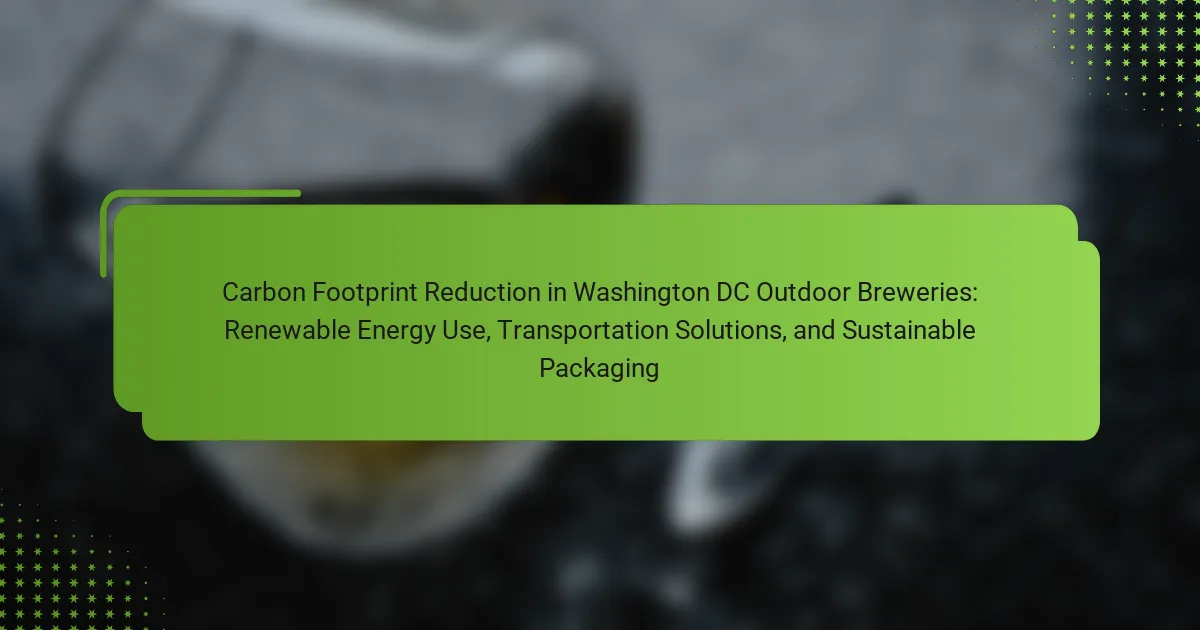The article focuses on carbon footprint reduction in Washington DC outdoor breweries, highlighting the significance of renewable energy use, transportation solutions, and sustainable packaging for environmental sustainability. It discusses how breweries can mitigate climate change by adopting renewable energy sources and implementing sustainable practices, such as using local ingredients, which can lead to a carbon footprint reduction of up to 50%. Additionally, the article addresses the role of electric vehicles (EVs) and improved public transit systems in lowering transportation emissions, alongside the importance of sustainable packaging in minimizing waste and carbon emissions by as much as 30%. These strategies collectively contribute to ecological health and enhance business viability within the brewing industry.

What is the significance of carbon footprint reduction in Washington DC outdoor breweries?
Carbon footprint reduction in Washington DC outdoor breweries is significant for environmental sustainability. It helps mitigate climate change effects by lowering greenhouse gas emissions. Breweries that adopt renewable energy sources can significantly decrease their reliance on fossil fuels. This transition not only benefits the environment but also enhances their brand reputation among eco-conscious consumers. Sustainable practices, such as using local ingredients, further reduce transportation emissions. A report by the Brewers Association states that breweries can cut their carbon footprint by up to 50% through such measures. Therefore, reducing carbon footprints is crucial for both ecological health and business viability in the brewing industry.
How does carbon footprint reduction impact the environment?
Reducing carbon footprint positively impacts the environment by lowering greenhouse gas emissions. This reduction helps mitigate climate change effects. It leads to improved air quality, benefiting human health and ecosystems. For instance, a study found that reducing carbon emissions could decrease respiratory diseases significantly. Additionally, less carbon dioxide in the atmosphere can enhance biodiversity. Healthier ecosystems support a wider variety of plant and animal species. Therefore, carbon footprint reduction contributes to a more sustainable and resilient environment.
What are the main contributors to carbon footprints in breweries?
The main contributors to carbon footprints in breweries include energy consumption, transportation, and raw material sourcing. Energy consumption is significant due to the heating and cooling processes involved in brewing. The brewing process can consume up to 30% of a brewery’s total energy use, primarily from fossil fuels. Transportation contributes to carbon emissions through the delivery of ingredients and distribution of finished products. This includes the carbon footprint associated with both local and long-distance shipping. Raw material sourcing also impacts carbon footprints, as ingredients like malt and hops require agricultural inputs that produce greenhouse gases. Additionally, water usage in brewing can contribute indirectly to carbon emissions through the energy used in water treatment and distribution. These factors collectively illustrate the complexity of carbon footprints in breweries.
Why is Washington DC a focal point for this initiative?
Washington DC is a focal point for the initiative due to its significant environmental policies. The city has established ambitious goals for carbon footprint reduction. These goals include achieving a 100% renewable energy supply by 2032. Washington DC is also home to numerous outdoor breweries that can lead sustainable practices. The local government actively supports initiatives that promote renewable energy and sustainability. Additionally, the city’s dense population allows for efficient transportation solutions. This makes it an ideal testing ground for innovative practices in the brewing industry. The combination of policy support and local engagement positions Washington DC as a leader in sustainability efforts.
What role does renewable energy play in carbon footprint reduction?
Renewable energy plays a critical role in carbon footprint reduction by providing cleaner alternatives to fossil fuels. It generates electricity with minimal or no greenhouse gas emissions. For instance, solar and wind energy systems do not emit carbon dioxide during operation. According to the International Energy Agency, transitioning to renewable energy could reduce global CO2 emissions by up to 70% by 2050. This shift is essential for achieving climate goals and mitigating climate change effects. In Washington DC, outdoor breweries utilizing renewable energy can significantly lower their carbon footprints. By adopting solar panels or wind turbines, these breweries contribute to a sustainable energy ecosystem.
What types of renewable energy sources are utilized by outdoor breweries?
Outdoor breweries utilize solar, wind, and biomass energy sources. Solar panels generate electricity for brewing processes. Wind turbines can provide power for operations as well. Biomass energy often comes from organic waste generated during brewing. These renewable sources help reduce carbon footprints. Studies show that transitioning to renewables can decrease greenhouse gas emissions significantly.
How does the use of renewable energy affect operational costs?
The use of renewable energy typically lowers operational costs. Renewable energy sources, such as solar and wind, have minimal ongoing fuel costs. This reduces the expenses associated with traditional energy sources. Additionally, renewable energy systems often qualify for tax incentives and grants. These financial benefits can further decrease overall operational costs. A study by the International Renewable Energy Agency found that renewable energy can lower electricity costs by up to 30% in some regions. This cost reduction can significantly benefit businesses, including outdoor breweries in Washington DC.

What transportation solutions are being implemented to reduce carbon footprints?
Electric vehicles (EVs) are being widely adopted to reduce carbon footprints in transportation. Many cities are investing in EV charging infrastructure. Public transit systems are incorporating electric buses to lower emissions. Biking and walking infrastructure is being enhanced to promote non-motorized transport. Carpooling and ride-sharing services are encouraged to reduce the number of vehicles on the road. Some organizations are implementing logistics solutions that optimize delivery routes to minimize fuel consumption. Additionally, there is a push for renewable energy sources to power transportation systems. These measures collectively contribute to significant reductions in greenhouse gas emissions.
How do transportation methods contribute to carbon emissions in breweries?
Transportation methods contribute to carbon emissions in breweries primarily through fuel consumption. Trucks and vehicles used for transporting raw materials and finished products release carbon dioxide during operation. The distance traveled also affects emissions, with longer distances resulting in higher carbon footprints. Additionally, the type of vehicle impacts emissions; older models tend to be less efficient. According to the EPA, freight transportation accounts for approximately 9% of total greenhouse gas emissions in the U.S. This statistic highlights the significant role of transportation in overall emissions. Strategies such as optimizing delivery routes can reduce these emissions effectively.
What sustainable transportation options are available for breweries?
Sustainable transportation options for breweries include electric vehicles, bicycles, and public transit partnerships. Electric vehicles reduce greenhouse gas emissions compared to traditional fuel options. Bicycles can be used for local deliveries, promoting health and reducing traffic congestion. Public transit partnerships allow breweries to leverage existing infrastructure for distribution. Additionally, using biofuels for delivery trucks can further lower carbon footprints. Implementing these options contributes to overall sustainability goals in the brewing industry.
How can breweries encourage eco-friendly transportation among customers?
Breweries can encourage eco-friendly transportation by promoting public transit options and providing incentives for customers using them. They can offer discounts or rewards for customers who arrive via bus, train, or bicycle. Breweries can also partner with local transit authorities to create special event routes or shuttles. Installing bike racks and providing secure storage for bicycles encourages cycling. Additionally, breweries can host events that highlight sustainable transportation, such as bike tours or carpooling initiatives. Research indicates that promoting public transit can lead to a 20% increase in its use among patrons. These strategies help reduce the carbon footprint associated with transportation to and from breweries.
What are the benefits of implementing sustainable transportation solutions?
Implementing sustainable transportation solutions reduces greenhouse gas emissions and improves air quality. These solutions include electric vehicles, public transit, and cycling infrastructure. Transitioning to electric vehicles can lower emissions by up to 50% compared to traditional gasoline vehicles. Public transit reduces the number of cars on the road, leading to decreased traffic congestion and pollution. Cycling infrastructure promotes healthier lifestyles and reduces reliance on fossil fuels. Research shows that cities with robust public transit systems experience a 45% reduction in per capita carbon emissions. Overall, sustainable transportation contributes to a healthier environment and community.
How do transportation solutions enhance brand reputation?
Transportation solutions enhance brand reputation by demonstrating a commitment to sustainability. Companies that adopt eco-friendly transportation practices can reduce their carbon emissions significantly. For instance, using electric vehicles or optimizing delivery routes can lower greenhouse gas emissions. This proactive approach resonates with environmentally conscious consumers. Research shows that 66% of consumers are willing to pay more for sustainable brands. Additionally, brands that prioritize sustainable transportation often see increased customer loyalty. A positive brand image can lead to enhanced market positioning. Overall, effective transportation solutions contribute to a robust and responsible brand reputation.
What are the long-term savings associated with sustainable transportation?
Sustainable transportation leads to significant long-term savings in various areas. These savings include reduced fuel costs due to increased efficiency and lower maintenance expenses for vehicles. For example, electric vehicles typically have lower operating costs compared to gasoline cars.
Additionally, sustainable transportation can decrease healthcare costs by reducing air pollution and its associated health risks. A study from the American Public Health Association indicated that improved air quality could save the U.S. healthcare system billions annually.
Moreover, sustainable transportation initiatives can lead to savings in infrastructure costs. Investments in public transit can reduce the need for extensive road maintenance.
Finally, cities that promote sustainable transportation often see increased economic activity. A report by the National Association of City Transportation Officials found that investments in cycling and pedestrian infrastructure can yield economic returns.

What is the importance of sustainable packaging in reducing carbon footprints?
Sustainable packaging is crucial for reducing carbon footprints. It minimizes waste and lowers greenhouse gas emissions. Traditional packaging often relies on non-renewable materials. In contrast, sustainable packaging uses biodegradable or recyclable materials. This transition can significantly decrease the environmental impact. Research indicates that adopting sustainable packaging can reduce carbon emissions by up to 30%. Moreover, it encourages responsible consumer behavior. By choosing eco-friendly options, consumers support a circular economy. This shift ultimately contributes to a healthier planet.
How does packaging contribute to the overall carbon footprint of breweries?
Packaging contributes significantly to the overall carbon footprint of breweries. It involves the production, transportation, and disposal of packaging materials. Common materials like glass, aluminum, and plastic have varying environmental impacts. For instance, producing glass bottles typically generates more carbon emissions compared to aluminum cans. Additionally, the transportation of these packaged products adds to the carbon footprint due to fuel consumption. According to a study by the Beverage Industry Environmental Roundtable, packaging accounts for about 30% of the total carbon emissions in the beverage sector. Furthermore, improper disposal of packaging materials can lead to increased landfill waste, further exacerbating the carbon footprint. Sustainable packaging solutions, such as biodegradable materials and recycling programs, can mitigate these impacts.
What types of sustainable packaging materials are available?
Biodegradable materials, recycled paper, glass, and plant-based plastics are types of sustainable packaging materials available. Biodegradable materials break down naturally, reducing landfill waste. Recycled paper is made from post-consumer waste, conserving resources and energy. Glass is recyclable and reusable, minimizing environmental impact. Plant-based plastics, derived from renewable resources, offer a lower carbon footprint compared to traditional plastics. These materials collectively contribute to reducing the carbon footprint in various industries, including breweries.
How can breweries transition to more sustainable packaging options?
Breweries can transition to more sustainable packaging options by adopting biodegradable materials and reusable containers. Utilizing materials like glass, aluminum, and plant-based plastics reduces environmental impact. Implementing a deposit return scheme encourages customers to return containers for reuse. Partnering with local suppliers for sustainable packaging reduces transportation emissions. Educating consumers on recycling options promotes responsible disposal. Research indicates that switching to sustainable packaging can reduce overall carbon emissions by up to 30%. Implementing these strategies not only benefits the environment but can also enhance brand loyalty among eco-conscious consumers.
What are the challenges faced in adopting sustainable packaging?
The challenges faced in adopting sustainable packaging include high costs, limited availability, and regulatory hurdles. Sustainable materials often have a higher price point compared to traditional packaging. This can deter businesses from making the switch. Additionally, the supply chain for sustainable materials may not be fully developed, leading to shortages. Regulatory challenges can arise from varying standards and certifications for sustainable packaging. These factors can complicate the decision-making process for breweries looking to implement sustainable practices. Moreover, consumer perception and demand for sustainable packaging can vary, impacting market viability.
How can breweries overcome these challenges effectively?
Breweries can effectively overcome challenges related to carbon footprint reduction by implementing renewable energy solutions. Utilizing solar panels can significantly decrease reliance on fossil fuels. Research indicates that solar energy can reduce greenhouse gas emissions by up to 90%. Additionally, breweries can invest in electric vehicles for transportation. This transition can lower emissions associated with logistics and distribution. Sustainable packaging options, such as biodegradable materials, can also minimize environmental impact. Studies show that adopting these practices can enhance brand reputation and consumer loyalty. Overall, integrating renewable energy, electric transportation, and sustainable packaging is essential for breweries to address their carbon footprint challenges effectively.
What role do consumers play in promoting sustainable packaging practices?
Consumers play a crucial role in promoting sustainable packaging practices. Their purchasing decisions influence brands to adopt eco-friendly packaging. When consumers prioritize products with sustainable packaging, companies respond by improving their practices. Research shows that 73% of consumers are willing to change their consumption habits to reduce environmental impact. Additionally, consumer demand for transparency drives brands to disclose their packaging materials. This accountability encourages businesses to innovate and reduce waste. As consumers advocate for sustainability, they create a market for environmentally responsible products. Their collective voice can lead to significant industry changes in packaging practices.
What best practices can breweries follow for effective carbon footprint reduction?
Breweries can follow several best practices for effective carbon footprint reduction. Implementing renewable energy sources is crucial. Utilizing solar panels can significantly lower energy costs and emissions. Transitioning to energy-efficient brewing equipment also reduces energy consumption.
Optimizing transportation logistics minimizes carbon emissions from distribution. Using local ingredients decreases transportation distances, further lowering the carbon footprint. Sustainable packaging options, such as recyclable materials, help reduce waste.
Adopting water conservation techniques is essential, as water treatment contributes to carbon emissions. Regular carbon footprint assessments can identify areas for improvement. Collaboration with environmental organizations can provide valuable resources and insights.
The main entity of this article is carbon footprint reduction in Washington DC outdoor breweries. The article outlines the significance of reducing carbon footprints for environmental sustainability and business viability, emphasizing the role of renewable energy, transportation solutions, and sustainable packaging. Key contributors to carbon emissions in breweries include energy consumption, transportation, and raw material sourcing. The article also highlights the challenges and best practices for implementing sustainable initiatives, showcasing the impact of consumer behavior on promoting eco-friendly practices in the brewing industry.
